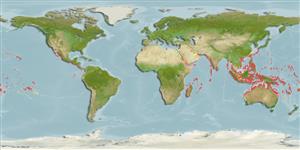分類 / Names
共通名の | 類義語 | Catalog of Fishes(部類, 種) | ITIS | CoL | WoRMS | Cloffa
>
Eupercaria/misc (Various families in series Eupercaria) >
Labridae (Wrasses) > Cheilininae
Etymology: Novaculichthys: Latin, novacula = razor + Greek, ichthys = fish (Ref. 45335).
More on author: Lacepède.
Environment: milieu / climate zone / depth range / distribution range
生態学
海 関連する礁; 深さの範囲 3 - 25 m (Ref. 30573), usually ? - 14 m (Ref. 27115). Tropical; 24°C - 28°C (Ref. 27115); 30°N - 30°S, 32°E - 77°W
Indo-Pacific: Red Sea to South Africa (Ref. 35918) and the Tuamoto Islands, north to Ryukyu and Hawaiian islands, south to Lord Howe Island. Excluding Persian Gulf (Ref. 86689). Eastern Pacific: Gulf of California to Panama and the Galapagos Islands (Ref. 5227).
サイズ / 重さ / 年齢
Maturity: Lm ? range ? - ? cm
Max length : 30.0 cm TL オス/雌雄の選別がない; (Ref. 2334)
背面の脊椎 (合計) : 9; 背鰭 (合計) : 12 - 13; 肛門の骨: 3; 臀鰭: 12 - 13. Juveniles have long extended dorsal fin spines (Ref. 48636).
Inhabit semi-exposed reef flats and lagoon and seaward reefs (Ref. 1602). Common in areas of mixed sand, and rubble that are subject to mild surge (Ref. 1602, 58466). Benthopelagic (Ref. 58302). Juveniles shallow on rubble amongst large bommies or protected open patches on reef crests and swim as if were a leaf floating along the bottom; large adults move along over large reef section, usually in pairs and typically turn or shift large pieces of rubble or debris that they grab and pull with their mouth or push over with their snout. Often, while one works the piece, the other grabs exposed prey. They are sometimes called rock-mover wrasse, but they don't move real rocks (Ref. 48636). Highly territorial (Ref. 9823). Feed on mollusks, sea urchins, brittle stars, polychaetes, and crabs (Ref. 5213); feeding is done by overturning large rocks to expose target preys. The young imitate drifting masses of algae (Ref. 2334). Marketed fresh (Ref. 9311). Minimum depth reported from Ref. 30874.
Life cycle and mating behavior
成熟 | 繁殖 | 放精 | 卵 | 生産力 | 幼生
Oviparous, distinct pairing during breeding (Ref. 205).
Randall, J.E., G.R. Allen and R.C. Steene, 1990. Fishes of the Great Barrier Reef and Coral Sea. University of Hawaii Press, Honolulu, Hawaii. 506 p. (Ref. 2334)
IUCNのレッドリストの状況は (Ref. 130435: Version 2024-1)
Human uses
Can't connect to MySQL database (fbapp). Errorcode: Too many connections
